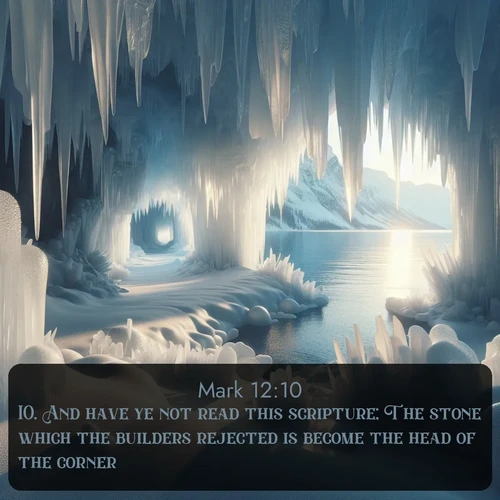Gospel of Mark 12:10 plusieurs versions / traductions
English Bible Translations
10. And have ye not read this scripture; The stone which the builders rejected is become the head of the corner:
10. Have ye not read even this scripture: The stone which the builders rejected, The same was made the head of the corner;
10. Have you not seen this which is in the Writings: The stone which the builders put on one side, the same was made the chief stone of the building:
10. Have ye not even read this scripture, The stone which they that builded rejected, this has become the corner-stone:
10. And have ye not read this scripture; The stone which the builders rejected is become the head of the corner:
10. And this Writing did ye not read: A stone that the builders rejected, it did become the head of a corner:
German Bible Translations
10. Habt ihr auch nicht gelesen diese Schrift: "Der Stein, den die Bauleute verworfen haben, der ist zum Eckstein geworden.
10. Habt ihr nicht auch dieses Schriftwort gelesen: «Der Stein, den die Bauleute verworfen haben, der ist zum Eckstein geworden.
French Bible Translations
10. »N'avez-vous pas lu cette parole de l'Ecriture: La pierre qu'ont rejetée ceux qui construisaient est devenue la pierre angulaire;
10. N’avez-vous pas lu cette parole de l’Ecriture:La pierre qu’ont rejetée ceux qui bâtissaientEst devenue la principale de l’angle;
10. N'avez-vous pas lu cette parole de l'Ecriture: La pierre qu'ont rejetée ceux qui bâtissaient Est devenue la principale de l'angle;
10. Et n'avez-vous pas même lu cette écriture: "La pierre que ceux qui bâtissaient ont rejetée, celle-là est devenue la maîtresse pierre du coin;
10. Et n'avez-vous point lu cette Ecriture? La pierre que ceux qui bâtissaient ont rejetée, est devenue la maîtresse pierre du coin;
10. Et n'avez-vous point lu cette parole de l'Écriture: La pierre que ceux qui bâtissaient ont rejetée, est devenue la principale pierre de l'angle?
Versions with Strong Codes
Mark 12 / KJV_Strong10.
Strong Code definitions
G3761 oude/oo-deh' from G3756 and 1161; not however, i.e. neither, nor, not even:--neither (indeed), never, no (more, nor, not), nor (yet), (also, even, then) not (even, so much as), + nothing, so much as. see G3756 see G1161
G314 anaginosko/an-ag-in-oce'-ko from G303 and 1097; to know again, i.e. (by extension) to read:--read. see G303 see G1097
G5026 taute/tow'-tay,/and tautes tow'-tace dative case, accusative case and genitive case respectively of the feminine singular of G3778; (towards or of) this:--her, + hereof, it, that, + thereby, the (same), this (same). see G3778
G1124 graphe/graf-ay' a document, i.e. holy Writ (or its contents or a statement in it):--scripture.
G3037 lithos/lee'-thos apparently a primary word; a stone (literally or figuratively):--(mill-, stumbling-)stone.
G3739 hos/hos, including feminine ho ho probably a primary word (or perhaps a form of the article 3588); the relatively (sometimes demonstrative) pronoun, who, which, what, that:-one, (an-, the) other, some, that, what, which, who(m, -se), etc. See also 3757. see G3588 see G3757
G3588 ho/ho, including the feminine to to in all their inflections; the definite article; the (sometimes to be supplied, at others omitted, in English idiom):--the, this, that, one, he, she, it, etc.
G3618 oikodomeo/oy-kod-om-eh'-o from the same as G3619; to be a house-builder, i.e. construct or (figuratively) confirm:--(be in) build(-er, -ing, up), edify, embolden. see G3619
G593 apodokimazo/ap-od-ok-ee-mad'-zo from G575 and 1381; to disapprove, i.e. (by implication) to repudiate:--disallow, reject. see G575 see G1381
G3778 houtos/hoo'-tos, including nom 3778] (houtos/hoo'-tos, including nominative masculine plural) haute how'-tay, and nominative feminine plural hautai how'-tahee from the article 3588 and 846; the he (she or it), i.e. this or that (often with article repeated):--he (it was that), hereof, it, she, such as, the same, these, they, this (man, same, woman), which, who. see G846 see G3588
G1096 ginomai/ghin'-om-ahee a prolongation and middle voice form of a primary verb; to cause to be ("gen"-erate), i.e. (reflexively) to become (come into being), used with great latitude (literal, figurative, intensive, etc.):--arise, be assembled, be(-come, -fall, -have self), be brought (to pass), (be) come (to pass), continue, be divided, draw, be ended, fall, be finished, follow, be found, be fulfilled, + God forbid, grow, happen, have, be kept, be made, be married, be ordained to be, partake, pass, be performed, be published, require, seem, be showed, X soon as it was, sound, be taken, be turned, use, wax, will, would, be wrought.
G1519 eis/ice a primary preposition; to or into (indicating the point reached or entered), of place, time, or (figuratively) purpose (result, etc.); also in adverbial phrases:--(abundant-)ly, against, among, as, at, (back-)ward, before, by, concerning, + continual, + far more exceeding, for (intent, purpose), fore, + forth, in (among, at, unto, -so much that, -to), to the intent that, + of one mind, + never, of, (up-)on, + perish, + set at one again, (so) that, therefore(-unto), throughout, til, to (be, the end, -ward), (here-)until(-to), ...ward, (where-)fore, with. Often used in composition with the same general import, but only with verbs (etc.) expressing motion (literally or figuratively).
G2776 kephale/kef-al-ay' from the primary kapto (in the sense of seizing); the head (as the part most readily taken hold of), literally or figuratively:--head.
G1137 gonia/go-nee'-ah probably akin to G1119; an angle:--corner, quarter. see G1119
Prédications qui analysent les thèmes Évangile selon Marc 12
Thèmes : La femme faible; La foi de la femmePrédication évangile de Marc 12 v 13-17 2eme partie
Prédication évangile de Marc 12 v 13-17
Related Sermons discussing Gospel of Mark 12
Themes : La femme faible; La foi de la femmesee also: Bible Key Verses ; KJV Bible Images, BBE Bible images
playlist des Paraboles sur Youtube ; le Podcast sur Spotify : Les Paraboles : Le Bon Samaritain, Le Fils Prodigue...

